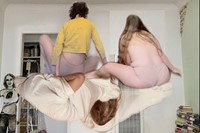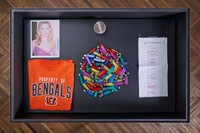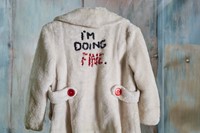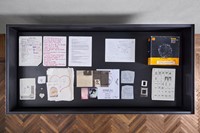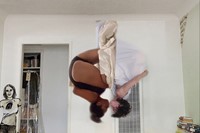Despite having turned 50 just a couple of weeks ago, New Society – at Fondazione Prada’s Osservatorio overlooking the rooftops of the Renaissance Revival era arcade the Galleria Vittorio Emanuele in Milan – is artist, author, director, actor and performer Miranda July’s first ever solo show.
“I’ve never had a curator!” she says, half giggling in her introduction to the show’s opening.
Just a little time in the exhibition will reveal the reason for that. Organised around her latest collaborative video work F.A.M.I.L.Y. (Falling Apart Meanwhile I Love You), New Society presents many of July’s live performances across more than 30 years (she started directing in high school, aged 17) and showcases projects she’s developed with strangers met on chance encounters – an Uber driver, a telemarketer, responders on Instagram. All are connected by their inclusivity.
“Maybe it’s part of my punk youth and my upbringing but [I’ve always felt that] everything should be available to everyone,” she says, in a sunny spot behind the elevator at her exhibition. “And that works really well with books and movies. But it doesn’t work so well with art – it’s not how value is created in the art world.” It does seem strange that, despite producing artwork for the last 33 years, with sculptures on show at the Venice Biennale and group and online shows, she’s never had a curator. “It’s because there was nothing to sell – I was going out of my way to make it less valuable, in a way.”
As well as videos from July’s performances – all edited and up-resed for the first time since their original performances – vitrines are filled with ephemera, props and costumes, documenting those shows. In the first, is a leaflet reading the words “Big Miss Moviola” and a grainy black and white image of a woman on the phone, over which is printed “I can do that”. The image served as an advert for July’s “underground distribution network”, a premise she started back when she was 20, inviting female filmmakers to send her a VHS tape with their own movie on it; the sender would receive a tape in return with 9 other female-made movies on it, alongside her own – a sort of chain letter tape. “It was before YouTube,” July explains. “This is how we can see each other’s work and therefore continue being filmmakers. I ran it for 10 years all the way up until I made my first feature. Hundreds of movies were made and shared.” July resisted the idea of editioning the tapes or exhibiting them, an approach only just entering gallery spaces at that time. “I’m doing this to make it more available,” she thought then, “so that more women can conceive of themselves this way. If I limit numbers of copies [and its visibility], then that doesn’t work for me – because the democratic notion is part of my art.”

The unique alchemical result of engaging with strangers dates back to July’s first piece – in fact, it spurred her very need to make art. Aged 17, July started a pen-pal relationship with a man in life-imprisonment – the ultimate stranger in the sense that, “our lives were completely strange to each other” – and found it alienated her from her peers. “The life I was learning more and more about, that I was emotionally tethered to, I didn’t have anyone else I could talk to about, other than him. In the most literal sense I was like, ‘I have to act this out – this is too much for me’.” The result was Lifers, a play she wrote and directed and put on at a local punk club while she was at high school. She didn’t act in the play, however. “I hadn’t overcome my teenage insecurity yet. But sitting in the audience watching, I thought, ‘OK this will be it for the rest of my life, in some way or another.’”
Twinned with this realisation of the need to express, was her developing need to push boundaries and experiment with the very parameters of our social existence. In talking to the man in prison, July was able to consider how subtly, but how completely “we are kept in our line,” she explains. “We know the people in our world, class tends to be a big part of what’s isolating us – though it’s difficult to talk about or point to. There’s no law about stepping outside of all that but at the very least it’s going to raise a lot of questions you don’t know the answer to. [I started thinking] Let’s make a mess here of what could be a perfectly smooth life, question the power dynamics, perhaps give away some power in a way that could be very uncomfortable – but that’s the only way that we can make new ground.”

Putting the spotlight on the uncomfortable is exactly what she does with F.A.M.I.L.Y., a series of videos created after July asked a set of strangers (online) to shoot videos of themselves alone in their space, with room for July, or fellow strangers to interact. With the guidance of her 11-year-old child, July used TikTok content-creating tools on an iPhone to cut herself, and the strangers out, and superimposed them into her home studio space. The effect is not at all seamless, the cut-out human forms bleed in and out, backgrounds pop in and out of the frame, as half-dressed bodies collide, clash and grope at one another, often in mid-air. In coming together, these unions draw attention to each subject’s aloneness – there’s a frisson when two people appear to kiss but sort of miss, the ghostly trail of a promise that is never fully materialised.
“I tried to create an image that gave us perhaps what we had wanted from the technology in the first place,” July explained in her introduction, “from social media, from Instagram in particular – I think we wanted to be looked at so lovingly that we felt OK. Of course, it’s impossible. I tried to do this via a sort of merging – a new kind of sex or birth. Sort of like what you imagined sex would be like as a child – that you would just merge. It would be this perfect togetherness.”

In the exhibition’s accompanying leaflet is a conversation between July and fellow artist Cindy Sherman who, with her works full of wigs, costumes and digital manipulation, is a clear kindred spirit. July tells Sherman that in the making of F.A.M.I.L.Y., she was often surprised by how sexual the work was coming out. I ask her why that might be.
“Often in my fiction I’ll be looking for a piece to read out and I’m like ‘Oop, not that…!’ I’m always a bit horrified. I think the issue is that when I’m alone and I’m almost always alone when I’m making the work. Sex doesn’t seem… it has a different quality. It’s almost like a metal that oxidises with air. [In my head] it’s very safe. It’s maybe not even really sex as we think of it. And then you go out into the open and people say [the work is] ‘hot’ or ‘erotic’ which is not not true. I’m happy if people enjoy that part. But it is a sort of alchemy that happens when you leave the space – I’m a little Victorian with other people if I don’t know them. Sometimes people relate to me as if I’m going to be like, ‘yeah let it all hang out,’ and I’m like, ‘Well I don’t know you at all – let’s not talk about that!’” In July’s work, her subconscious self clashes with the outside world and it’s in this rift that the art itself is made.
“You go out into the open and people say [the work is] ‘hot’ or ‘erotic’ which is not not true. I’m happy if people enjoy that part. But it is a sort of alchemy that happens when you leave the space” – Miranda July
July remembers her first performance after releasing her feature film Me, You and Everyone We Know as the point at which she began to invite strangers into the works themselves, as if to destabilise her newfound platform. “It was like ‘Well, this is too simple now – you’re all just coming to see the girl in the movie … But it took all this time to locate myself, and create space for myself, like, I gained a little power, so then started opening myself up to the world.” Was the film a marker of establishing herself then? “I guess it’s not the feature so much,” she says. “The feature was the beginning. At that time it was like, ‘a woman really could make a movie’. That was really just the beginning of getting my foot in the door…”
As well as serving to document the life and soul of July’s projects over the years – the intensely scribbled notebooks, diagrams, home-made props and Xeroxed posters she’d handed out – the vitrines are testament to something more profound, they represent the audacious space-occupying required to keep an archive as a young artist that effectively, no one knows. These items appear here for the first time, after July invited the show’s curator Mia Locks to rummage through her fairly disordered boxes, which held the physical remnants of her very ephemeral early works. “I was a young punk feminist, and [when I met an archivist] in my 20s, I realised that what is saved is remembered and what is remembered becomes history and history creates reality. No one was going to save or keep or remember the work of a young woman who no one knew about – but if I saved it, and I just kept saving it ... This wasn’t like, ‘I’m going to be so famous’ – it was because I realised archives are radical. And there had not been archives of most kinds of people – only one kind of person.”
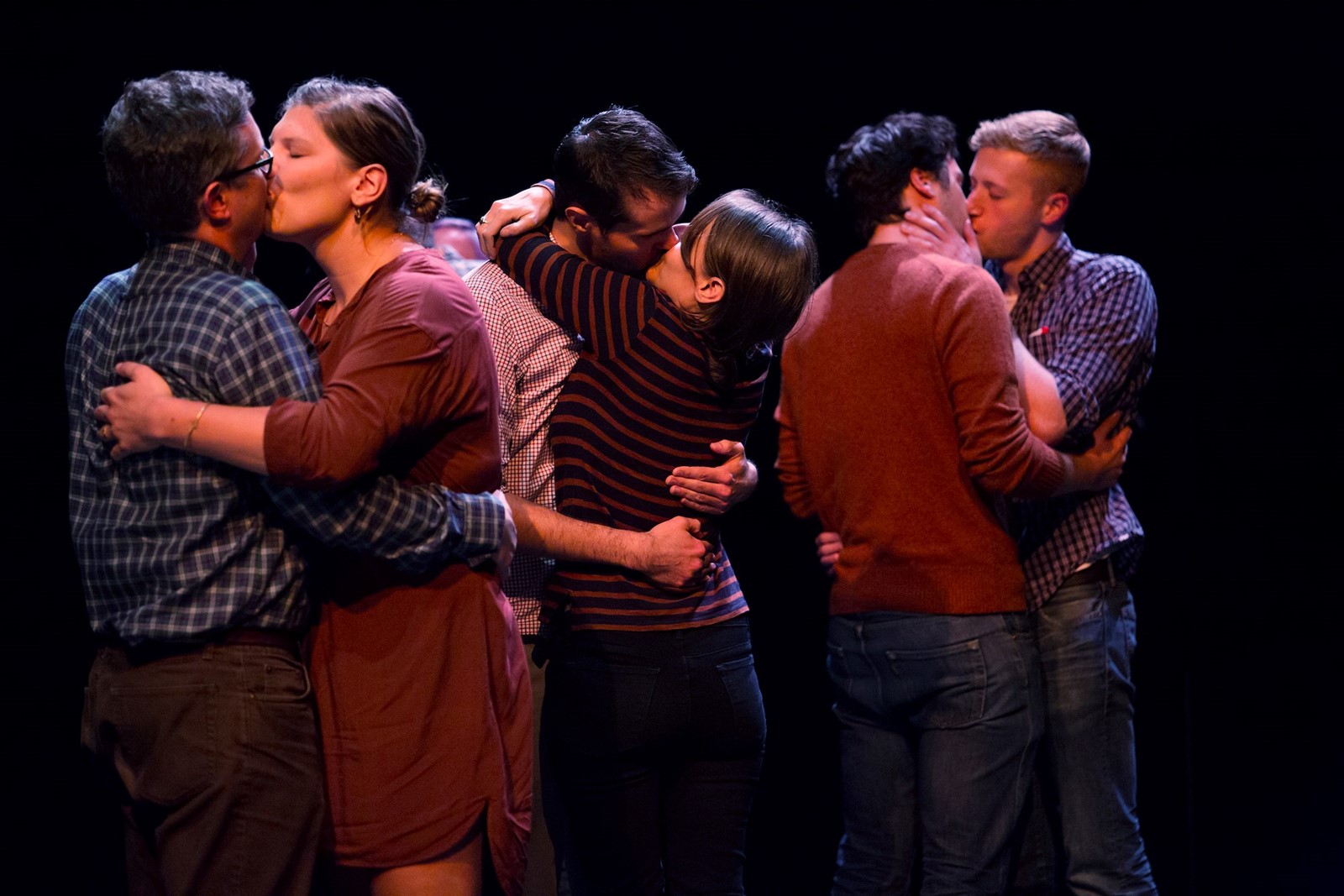
While it’s a hopeful and powerful act, July’s radical archive also speaks of her deep need to be present in the current moment – to catalogue the now, both takes hold the present but simultaneously looks forward. “I wish I could live in this present moment forever!” she exclaims in New Society, a performance piece she presented at Brooklyn Academy of Music in 2015 (as well as the name of this current exhibition). In this work, July plays the role of “artist-cum-nation-builder”, as Locks describes it, and invites the audience to stay with her in the theatre forever to create a new society, which they vote on, and do. They design a constitution, write an anthem, design a flag. It’s a “wonderful social experiment that unfolds in real time where you see the audience playing themselves,” Locks continues. By the performance’s close, July explains to the audience that 20 years have passed, all the bees died, the horses died, the whales died, it’s hotter out – people are worried, but not too worried as all this happened gradually. In occupying 20 years in the space of the play July draws the present moment out over an elastic timeline – the audience, fully enrolled in the experience, entwined as actors, are both in the present moment, the auditorium, and their imaginations at once.
But why is being in the present so important?
“It’s because I’m so not in the moment,” answers July. “My dream life, fantasy life often spills over into my work and my fiction – it’s so thick and massive that I could easily never leave home. I can just sit here happily and play the reels of my mind, so it’s almost like fear that I will miss this life – I have to puncture it. I don’t know why, I always had that. It’s so hard for me to get out of it because I love it. It’s kind of paralysing.”
“My dream life, fantasy life often spills over into my work and my fiction – it’s so thick and massive that I could easily never leave home. I can just sit here happily and play the reels of my mind, so it’s almost like fear that I will miss this life – I have to puncture it” – Miranda July
What would happen if you just stayed there? I ask.
“Whenever I see a miss Havisham character, I’m always like, ‘there but for the grace of God, go I’,” she laughs. With Dickens’ famed character in mind, I ask her about ageing – there’s certainly something significant in having her first solo show just after turning 50, not just with regard to the legacy on show but also when her own physicality is so much part of the art and the show serves as a sort of time capsule.
How has that experience of having eyes on the body changed over the years? “When I look at these early performances, I’m in a bathing suit in a couple of pieces, I’m just standing there. I’m not taking up a ton of space with the body – maybe the projection is. And I’m not moving a lot. F.A.M.I.L.Y. is like a dance, though – my body is always doing something – and that came with age. It suddenly seemed more interesting seeing this body doing those things. And you do imagine yourself from the outside and I thought, ‘I’d like to see that, I’d like to see a 49 year old (I was at the time), doing that’. In fact, I sort of needed that. Actually, I just started a saved folder called ‘Old Women’ on my Instagram – it gives me that feeling that what’s coming is interesting, there’s room there.”
Watching Miranda July in full force, embodying her generosity and joyful play with her whole body, gives me the exact same feeling.
New Society by Miranda July is on show at Fondazione Prada Osservatorio in Milan until October 14.

